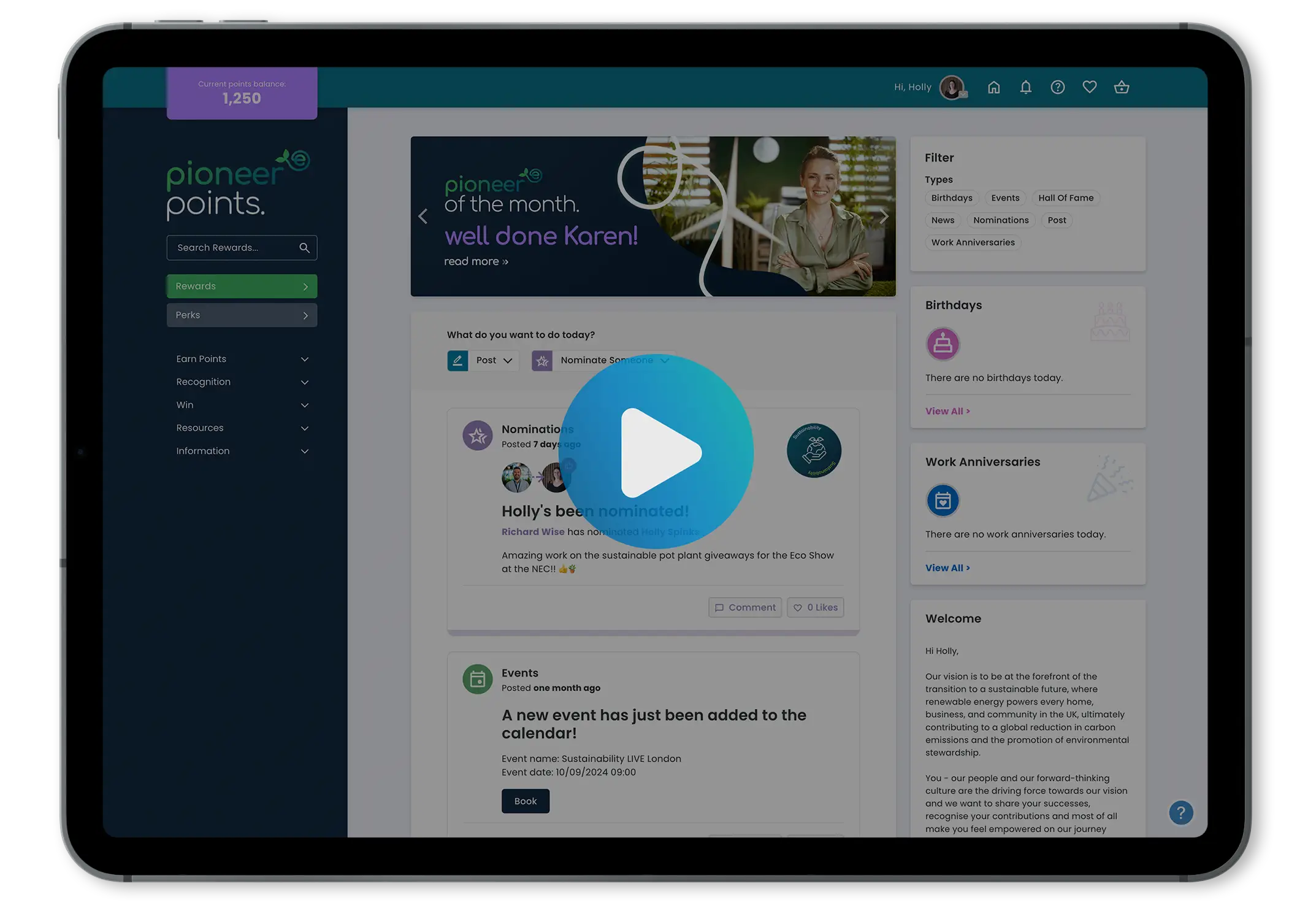


A carefully crafted loyalty points programme does far more than hand out freebies and discounts. It creates meaningful relationships with your customers, encourages repeat business and gives your brand a competitive edge (as who doesn’t enjoy collecting points?). When customers feel genuinely valued, they’re far more likely to stick around, spend more and sing your praises to others.
In this blog, we’re diving into the world of loyalty rewards and what it really takes to build a successful loyalty points programme. From the psychology behind point-collecting behaviour to the nuts and bolts of setting up your own system, we’ll cover everything you need to know. You’ll get practical tips, plenty of real-world examples and a few watch-outs along the way… because not all points programmes are created equal.
Whether you’re launching your very first loyalty initiative or looking to fine-tune an existing one, this guide will help you turn those loyalty points into long-term business growth (and maybe even a few happy dances from your customers).
Skip to:
What are loyalty points?
Loyalty points are a clever way for businesses to encourage repeat purchases by rewarding customers with points every time they shop. They can also be offered whenever customers take other useful actions, like signing up to a newsletter, completing a profile or referring a friend. These points gradually build up and can be exchanged for loyalty rewards such as discounts, freebies, gift cards, exclusive merchandise or even VIP experiences (depending on how generous – and creative – your loyalty points programme is).
Points-based loyalty schemes are especially popular in industries like retail, hospitality, airlines, credit cards and ecommerce, where competition is fierce and customer retention is key. The aim is simple: reward customers for their loyalty and keep them coming back, rather than letting them drift off to a competitor offering the next best deal.
By offering loyalty rewards, businesses hope to move away from one-time transactional relations and build a strong bond with their customers (otherwise known as ‘customer loyalty’). It’s a way of saying ‘thank you’ for their support and keeping them engaged with the brand. In turn, they’ll choose your products or services over others.


Why use loyalty points? (over other loyalty reward structures)
Loyalty points systems are favoured by businesses for many compelling reasons, often making them a preferred choice over alternative loyalty reward structures. There are various benefits to be taken into account, including:
- Flexibility: Loyalty points offer flexibility both for customers and businesses. Customers can accumulate points over time and redeem them for rewards that suit their preferences. For businesses, this system allows them to offer a wide range of rewards without committing to specific discounts or incentives upfront.
- Customisation: Loyalty points systems can be tailored to fit the needs and goals of a specific business. Companies can adjust earning rates, redemption options and bonus promotions based on their target audience and product offerings.
- Retention: By rewarding customers for their repeat business, companies encourage customers to remain loyal and advocate for their products or services. This helps to reduce customer churn, increase lifetime customer value and drive in referred prospects.
- Data collection: Loyalty points programmes provide businesses with valuable data about their customer’s preferences, purchasing habits and engagement patterns. This data can be used to segment customers, personalise marketing efforts and improve overall customer experience.
- Competitive advantage: Offering loyalty points can differentiate a business from its competitors and attract new customers. Customers are often drawn to brands that provide additional value through rewards and incentives, giving businesses a competitive edge in the market.
- Psychological impact: The accumulation of loyalty points can create a sense of progress and achievement for customers, encouraging them to continue earning points and reaching higher reward tiers. This psychological effect can foster stronger emotional connections between customers and the brand.


How much are loyalty points worth?
In most cases, loyalty points hold a monetary value, meaning they can be exchanged for goods within a catalogue, discounts in store, free products/upgrades or other perks. However, the worth of loyalty points can vary significantly depending on the specific programme, as companies can define this value upon launch.
For instance, in a retail loyalty programme, customers might earn 10 points with each purchase and these points could eventually be redeemed for vouchers or discounts on future purchases. The value of each point might be fixed, such as 1 point equaling £0.01 or it could fluctuate based on promotions or special offers.
In airline or hotel loyalty, the value of points can be more complex.
Points might be redeemable for flights, hotel stays, upgrades or even experiences like concert tickets or dining vouchers. The value of points in these programmes can vary based on factors such as the destination, availability and demand.
For example, redeeming points for a flight during peak travel season might require more points than during off-peak times.
It’s important for customers to understand how loyalty points are earned and how they can be used effectively. Keeping track of the value of loyalty points and understanding the redemption options can help customers make the most of their loyalty reward memberships.

How to structure a points-based loyalty programme
Designing a loyalty points programme isn’t just a case of throwing around a few discounts and hoping for the best. It takes a bit of brainpower (and a dash of creativity) to strike the right balance between irresistible loyalty rewards and your business goals.
You’ll want a structure that gets customers earning, redeeming and coming back for more. That means designing loyalty points in a way that drives the behaviours you actually want (like repeat purchases, referrals or finally filling in that email field they’ve been ignoring for six months).
So, before you go wild with freebies, let’s walk through what it really takes to build a loyalty points programme that works hard behind the scenes.
Here are the key things to think about when structuring yours:
 Set clear objectives
Set clear objectives
Before you start dishing out loyalty points like confetti, it’s important to get crystal clear on what you’re actually trying to achieve. Are you looking to encourage customers to shop more often? Spend more per visit? Refer their mates? Or simply stick around long enough to remember your name?
Having solid goals from the get-go means you can build a loyalty points programme that rewards the behaviours you really want to see. Whether it’s boosting basket sizes or turning one-time buyers into loyal brand champions, your loyalty rewards should be pulling in the same direction as your business strategy.
No guesswork, just results (with a few happy customers along the way).
 Understand your customers
Understand your customers
Start by conducting thorough market research and analysing customer data to gain insights into your target audience’s preferences and shopping behaviours.
This might involve gathering information on demographics, purchasing patterns, preferred communication channels and factors influencing brand loyalty.
In doing so, you can uncover valuable insights about what drives your customers’ purchasing decisions and how they interact with your brand, which should help you tailor your rewards to resonate with their needs and interests.
For example, if your research reveals that your customers value personalised experiences, you might consider offering tailored rewards or exclusive perks based on their individual preferences. Alternatively, if your target audience is price-sensitive, you might focus on providing discounts or incentives to encourage repeat purchases (but be wary of the negative spiral discounting can induce… incentives are far more likely to deliver positive results longer term).
 Define reward point-earning opportunities
Define reward point-earning opportunities
Time to get creative and think beyond mere purchases: perhaps your customers could bag bonus points for signing up to your VIP newsletter, referring a mate who actually redeems, posting a glowing review, tagging you on social media or even turning up at your next pop-up event?
By mixing up these earning opportunities, you’ll keep everyone on their toes. Enthusiasts will chase points like there’s no tomorrow, while casual browsers might join in just to see what all the fuss is about. Plus, the more ways you offer to earn, the broader the appeal of your loyalty rewards and the higher the chances customers will stick around for the long haul.
 Establish point value and tiers
Establish point value and tiers
Here’s where your loyalty points start to mean something. You’ll need to decide how much each point is actually worth and what sort of loyalty rewards customers can trade them in for. Get the balance right and customers will be racing to rack up points. Get it wrong, and they’ll wonder why they bothered collecting them in the first place.
Throw in some bonus loyalty points for good measure – like extra rewards for big spends, promotional events or social shares – and you’ve got yourself a points party that encourages the behaviours that matter to your business.
And if you really want to dial things up, add tiers to your loyalty points programme. Think bronze, silver, gold… or whatever fits your brand vibe.
The higher the tier, the better the perks. This taps into that universal truth: people love to feel special. And when your top customers feel recognised and rewarded, they’re more likely to stick around and keep spending.

 Communicate the programme’s details clearly
Communicate the programme’s details clearly
Transparency and clarity are key to fostering trust and encouraging active participation with your loyalty programme. So, be sure to utilise a variety of communication channels to reach your audience and convey the benefits, such as:
- Website: Create a dedicated section on your website that outlines the key features of your loyalty reward offering. Provide clear and concise information about how customers can earn points, what rewards they can redeem and how they can track their progress.
- Email newsletters: Send regular email newsletters to your customer base to keep them informed about the latest updates and promotions. Highlight earning opportunities, exclusive offers and success stories from other members to encourage engagement.
- Social media: Leverage your social media platforms to raise awareness. Share engaging content that showcases the benefits of participation and encourages followers to join in. Respond promptly to customer enquiries and feedback to demonstrate your commitment to customer satisfaction.
- In-store signage: Place prominent signage in your physical store locations to inform customers. Use eye-catching visuals and concise messaging to capture their attention and encourage sign-ups.
- Mobile apps: If you have a mobile app, integrate information directly into the app interface. This allows customers to easily access details, track their points and redeem rewards while on the go.
 Implement tracking management systems
Implement tracking management systems
Effective tracking lies at the heart of a thriving loyal customer community. Monitoring systems oversee every aspect of the programme’s operations to ensure its smooth functioning and success.
By employing dedicated software tailored to manage loyalty initiatives and (even better) by integrating it into existing Customer Relationship Management (CRM) systems, businesses can ramp up their loyalty experience.
These systems are multifaceted, adeptly tracking the accumulation of customer points, the process of redeeming rewards and the dynamic management of membership tiers.
For instance, they monitor customer interactions, such as purchases, referrals and engagement with promotional activities, accurately crediting points to their accounts.
This not only eliminates manual tracking errors but also provides valuable insights into customer behaviour, which in turn allows for more targeted and effective marketing strategies. Additionally, these systems play a pivotal role in managing membership tiers. They automatically track customer progress and assign appropriate tier benefits based on accumulated points or other qualifying criteria.
 Monitor performance
Monitor performance
Stay on top of your programme’s performance by consistently monitoring various important metrics. These metrics include customer participation rates, trends in point accumulation and redemption, and the overall return on investment (ROI) of the programme. By analysing this data regularly, you can gain valuable insights into how effectively your programme is engaging customers and driving business results.
Monitoring trends in point accrual and redemption provides a window into customer behaviour and preferences. You can identify which rewards are most popular among customers, as well as any patterns in how points are being earned and spent. This information can help guide decisions on adjusting reward offerings or introducing new incentives to better align with customer interests.
Assessing the ROI of your loyalty efforts allows you to evaluate financial performance and determine whether you are delivering a satisfactory return on your investment.
By comparing the costs associated with running the programme to the revenue generated from increased customer retention and spending, you can gauge its overall effectiveness and make informed decisions about future investments.

Examples of loyalty points in action
We highlighted some exceptional loyalty schemes offered by top brands here. And below, you’ll find a few more case studies that have proven effective in engaging customers and enhancing brand loyalty over the last few years…
Retail loyalty rewards
Retail loyalty programmes are instrumental in nurturing customer loyalty and encouraging repeat business within the retail sector. Several prominent examples include the Sainsbury’s Nectar Card, Tesco Clubcard and Boots Advantage Card.
Airline loyalty programmes
Airline flyer schemes are essential tools for rewarding frequent traveller’s and fostering customer loyalty within the competitive aviation industry. Two prominent examples include the British Airways Executive Club and the Virgin Atlantic Flying Club.

Fitness and wellness
Fitness and wellness rewards play a significant role in motivating individuals to maintain healthy lifestyles while fostering loyalty to specific gym chains or wellness centres. One such example is PureGym, a prominent gym chain in the UK.
PureGym’s loyalty programme, PureGym Plus, gives members the chance to earn points by attending classes, referring friends to join the gym and even achieving personal fitness milestones. The rewards available include complimentary gym passes, allowing members to bring guests or access additional facilities beyond their regular membership. Alternatively, members may have the option to exchange their points for exclusive merchandise, such as branded apparel or fitness accessories. Moreover, PureGym Plus may offer discounts on supplementary services or amenities, such as personal training sessions, nutritional consultations or specialised fitness classes.
Need help creating a points-based loyalty reward programme?
If the thought of setting up a loyalty points programme makes your head spin, don’t worry – you’re not alone (and you’re definitely in the right place). With heaps of experience in B2B points programmes, we’re experts at building tailored loyalty reward schemes that actually work – especially for trade-focused businesses.
Whether you’re aiming to boost customer retention, ramp up sales or build brand loyalty that overpowers competitor offers, our team’s here to help make it happen.














